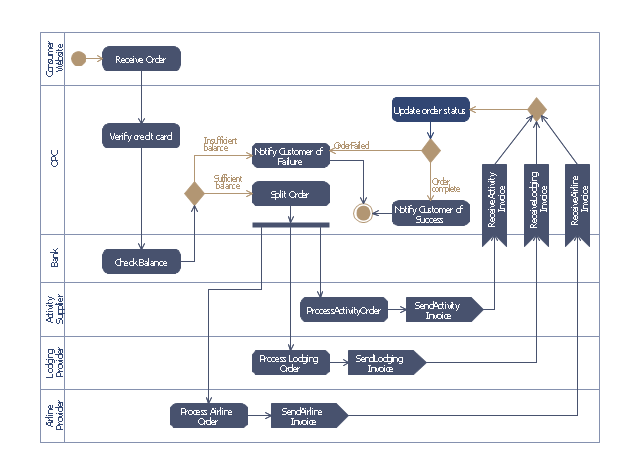This purchase order processing UML activity diagram was created on the base of activity diagram from the software architecture documentation wiki of the Software Engineering Institute (SEI) of Carnegie Mellon University (CMU).
[wiki.sei.cmu.edu/ sad/ index.php/ Image:PurchaseOrderActivityDiagram.png]
"A purchase order (PO) is a commercial document and first official offer issued by a buyer to a seller, indicating types, quantities, and agreed prices for products or services. Acceptance of a purchase order by a seller forms a contract between the buyer and seller, so no contract exists until the purchase order is accepted. It is used to control the purchasing of products and services from external suppliers.
Creating a purchase order is typically the first step of the purchase to pay process in an ERP system." [Purchase order. Wikipedia]
This purchase order processing UML activity diagram example was created using the ConceptDraw PRO diagramming and vector drawing software extended with the ATM UML Diagrams solution from the Software Development area of ConceptDraw Solution Park.
[wiki.sei.cmu.edu/ sad/ index.php/ Image:PurchaseOrderActivityDiagram.png]
"A purchase order (PO) is a commercial document and first official offer issued by a buyer to a seller, indicating types, quantities, and agreed prices for products or services. Acceptance of a purchase order by a seller forms a contract between the buyer and seller, so no contract exists until the purchase order is accepted. It is used to control the purchasing of products and services from external suppliers.
Creating a purchase order is typically the first step of the purchase to pay process in an ERP system." [Purchase order. Wikipedia]
This purchase order processing UML activity diagram example was created using the ConceptDraw PRO diagramming and vector drawing software extended with the ATM UML Diagrams solution from the Software Development area of ConceptDraw Solution Park.
 Event-driven Process Chain Diagrams
Event-driven Process Chain Diagrams
Event-driven Process Chain (EPC) Diagram is a type of flowchart widely used for modeling in business engineering and reengineering, business process improvement, and analysis. EPC method was developed within the Architecture of Integrated Information Systems (ARIS) framework.
- Uml Diagrams Of Image Processing
- Object Diagram For Image Processing System
- Purchase order processing UML activity diagram | UML Tool & UML ...
- Class Diagram For Image Processing
- Download Class Diagram From Image Processing Technique
- Image Enhancement Project With All Uml Diagrams
- Uml Diagrams For Enhancement In Image Processing Pdf
- Class Diagram Of Image Processing Project
- Rapid UML | Image Processing Diagrams
- UML Deployment Diagram | Process Flowchart | Entity-Relationship ...
- Er Diagram For Image Processing Project
- Use Case Diagram For Image Enhancement
- Er Diagram Of Image Processing
- Uml Diagram For Image Editor
- Uml Diagram Banking System Algorithm Image
- Data Flow Diagram For Image Processing
- Context Diagram Of Image Processing
- Event-driven Process Chain Diagrams | Purchase order processing ...
- Banking System | UML Diagram | UML Use Case Diagram Example ...
